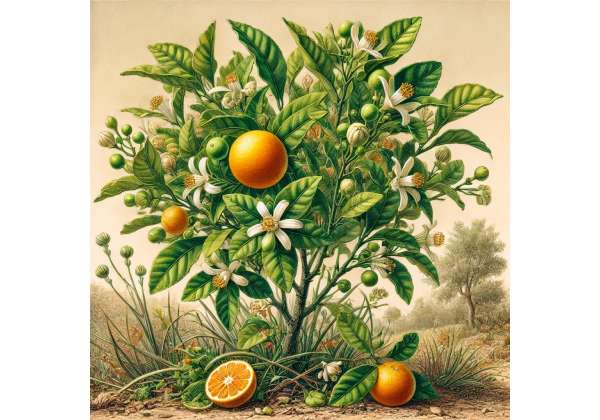Bitter orange, scientifically known as Citrus aurantium, is a versatile fruit with a rich history in traditional medicine, culinary arts, and perfumery. Native to Southeast Asia and the Mediterranean, this citrus plant has long been valued for its robust flavor, fragrant oils, and therapeutic properties. Whether used to support digestion, promote weight loss, or alleviate respiratory conditions, bitter orange offers a wide range of health benefits backed by both traditional wisdom and modern science. This guide explores the botanical features, historical significance, phytochemistry, health advantages, and practical applications of this remarkable citrus fruit.
Understanding Bitter Orange: Botanical Description and Characteristics
Tree Features
Bitter orange is an evergreen tree that typically grows to a height of 10–20 feet. Its dense, rounded crown and thorny branches are adorned with glossy, dark green leaves that are aromatic when crushed.
Flowers and Fruit
The tree produces fragrant white flowers that bloom in clusters, attracting pollinators such as bees. The fruit is round or slightly flattened, with a thick, dimpled peel that transitions from green to bright orange as it ripens. Unlike sweet oranges, bitter orange has a notably tart and pungent flavor.
Habitat and Growing Conditions
Citrus aurantium thrives in tropical and subtropical climates, favoring well-drained soils and full sunlight. It is cultivated widely in regions such as southern Europe, North Africa, and parts of the Americas.
Historical Roots: Bitter Orange in Culture and Medicine
Ancient Origins
Bitter orange has been cultivated for thousands of years, with origins tracing back to Southeast Asia. It was introduced to the Mediterranean by Arab traders around the 9th century and quickly became a staple in European gardens.
Medicinal Uses in Traditional Practices
In Ayurveda and Traditional Chinese Medicine (TCM), bitter orange has been used to treat indigestion, nausea, and respiratory conditions. The peel, in particular, was prized for its warming properties and ability to stimulate digestion.
Culinary and Cultural Significance
Bitter orange has played an essential role in culinary traditions worldwide. It is used to make marmalades, syrups, and liqueurs such as Grand Marnier and Cointreau. In some cultures, the fruit symbolizes prosperity and is exchanged during festive occasions.
Active Compounds and Phytochemistry of Bitter Orange
The health benefits of bitter orange are derived from its rich array of bioactive compounds, many of which are concentrated in the peel and essential oil.
Key Phytochemicals
- Synephrine: A natural stimulant that supports metabolism and weight management.
- Flavonoids: Including hesperidin and naringin, which have antioxidant and anti-inflammatory properties.
- Limonene: An essential oil with antimicrobial and mood-enhancing effects.
- Pectin: A dietary fiber that supports digestive health.
- Vitamin C: An immune-boosting antioxidant that aids in skin repair.
- Coumarins: Compounds with potential anticarcinogenic and anticoagulant properties.
Health Benefits of Bitter Orange: A Natural Remedy for Various Ailments
1. Supports Weight Loss and Metabolism
The synephrine in bitter orange is a natural thermogenic compound that increases metabolic rate and energy expenditure. It is a popular ingredient in weight loss supplements.
2. Enhances Digestive Health
Bitter orange peel stimulates the production of digestive enzymes, alleviating bloating, indigestion, and nausea. Its high fiber content supports regular bowel movements and a healthy gut microbiome.
3. Promotes Cardiovascular Health
Flavonoids such as hesperidin help lower blood pressure, improve circulation, and reduce cholesterol levels, supporting overall heart health.
4. Boosts Immune Function
Rich in vitamin C and antioxidants, bitter orange strengthens the immune system and protects cells from oxidative stress, reducing the risk of chronic diseases.
5. Alleviates Respiratory Conditions
Bitter orange’s expectorant properties help clear mucus and alleviate symptoms of colds, bronchitis, and sinus congestion.
6. Reduces Inflammation
The anti-inflammatory properties of bitter orange make it effective in managing conditions such as arthritis and other inflammatory disorders.
7. Antimicrobial and Antifungal Effects
Essential oils from bitter orange exhibit antimicrobial activity, making them useful for treating skin infections, wounds, and fungal conditions such as athlete’s foot.
8. Enhances Skin Health
Bitter orange oil is widely used in skincare products for its ability to reduce acne, brighten skin tone, and promote collagen production.
9. Relieves Stress and Enhances Mood
The limonene in bitter orange essential oil has calming effects that reduce stress and anxiety while promoting mental clarity and focus.
Methods of Preparation and Usage: Unlocking the Potential of Bitter Orange
Bitter orange can be utilized in various forms, from fresh fruit and peel to extracts and essential oils.
1. Culinary Uses
- Marmalades: The tartness of bitter orange makes it ideal for making marmalades and preserves.
- Liqueurs: Bitter orange peel is a key ingredient in crafting liqueurs such as Triple Sec.
- Cooking and Baking: The zest can be added to cakes, sauces, and marinades for a tangy flavor.
2. Teas and Infusions
Bitter orange peel can be dried and steeped in hot water to create a tea that aids digestion and promotes relaxation.
3. Essential Oils
- Aromatherapy: Diffuse bitter orange oil to reduce stress and uplift mood.
- Topical Use: Mix a few drops of essential oil with a carrier oil for skin applications or massage.
4. Supplements
Capsules and tinctures containing bitter orange extract are available for weight management and metabolic support.
Dosage and Safety Guidelines: Ensuring Responsible Use
Recommended Dosage
- Fresh Fruit or Juice: Consume in moderation, as the high acidity may irritate the stomach.
- Tea: 1–2 cups daily, prepared with dried peel.
- Essential Oil: Use 2–3 drops for diffusion or topical applications.
- Supplements: Follow the manufacturer’s dosage guidelines, typically 100–150 mg of synephrine per day.
Safety Precautions
- Pregnancy and Breastfeeding: Consult a healthcare provider before use, as bitter orange may stimulate uterine contractions.
- Medication Interactions: Bitter orange can interact with certain medications, including blood pressure and antidepressant drugs.
- Overuse Risks: Excessive consumption of synephrine-containing products may lead to increased heart rate and blood pressure.
Latest Research and Studies on Bitter Orange
1. Weight Management
A 2023 study in the Journal of Clinical Nutrition confirmed that synephrine boosts metabolic rate and fat oxidation without significant side effects.
2. Antimicrobial Properties
Research in 2024 demonstrated the efficacy of bitter orange essential oil against common pathogens, including E. coli and Candida albicans.
3. Cardiovascular Benefits
A 2022 clinical trial highlighted hesperidin’s role in improving endothelial function and reducing oxidative stress in patients with hypertension.
4. Skin Health Applications
A 2025 study published in the Journal of Dermatological Science found that bitter orange oil reduced acne lesions and improved skin texture in participants.
Seven Fascinating Facts About Bitter Orange
- Origins of Marmalade: Bitter orange is the key ingredient in traditional marmalade, first popularized in 18th-century Scotland.
- Historic Medicinal Use: The fruit was prescribed in medieval Europe for treating fevers and digestive issues.
- Global Cultivation: Bitter orange is grown in over 30 countries, with major producers including Spain, Italy, and Morocco.
- Perfume Industry Staple: The essential oil from bitter orange flowers, known as neroli, is a prized component in luxury perfumes.
- Symbol of Prosperity: In Chinese culture, bitter orange is associated with luck and is commonly used in Lunar New Year celebrations.
- Natural Preservative: Bitter orange peel contains compounds that act as natural preservatives in food and skincare products.
- Versatile Uses: Every part of the plant—fruit, peel, flowers, and leaves—has a unique application in medicine, cooking, or perfumery.
Disclaimer
This article is for informational purposes only and should not be considered medical advice. Always consult a healthcare professional before starting any new dietary or health regimen.
If you found this guide on bitter orange helpful, share it with your friends and family! Use the Facebook and X (formerly Twitter) share buttons below or spread the word on your favorite social media platforms. Together, we can celebrate the many benefits of this incredible citrus fruit.













